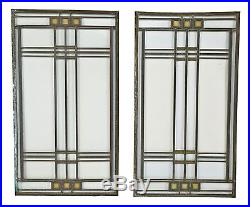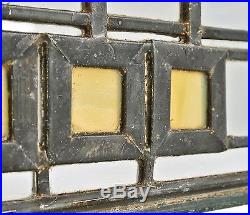Single (listing for ONE window) all original and intact frank lloyd wright-designed avery coonley residential art glass window executed by the linden glass company, chicago, ills. The window was originally located in the coonley house family room. The wood sash frame was removed long ago. The leaded glass window contains zinc caming with a bronze wash. No breaks or cracks evident. Only one available for sale. The other (pictured) is apart of the bldg. The avery coonley house (built 190812) is one of three estates that frank lloyd wright developed and is one of his largest and most elaborate prairie school-homes ever built. The two other multi-building prairie complexes built by the famed architect are the dana-thomas and darwin d. The coonley house is also the first example in wright’s work of a zoned plan. The raised second floor includes three zones: the public area (living room and dining room), the bedroom wing (with its pendant guest wing) and finally the kitchen and servants areas. The original residence was over-9000-square-feet and built on a ten-acre parcel. The entrance halls, playroom and sewing room are on the ground floor. An entire complex of interrelated buildings with extensive raised and sunken gardens was designed by landscape architect jens jensen. The main structure of the avery coonley estate is the public-living room wing, located on bloomingbank road and behind that facing scottswood road is the bedroom wing of the mansion. The complex also includes a separate stable-coach house and gardener’s cottage (1911). Along with the robie house, the coonley estate represents the maturation of wright’s prairie style, typified by wide overhanging eaves, bands of several art glass “screens” pr casement windows, free-flowing interior spaces and the harmonious blending of surrounding site and structure. Avery coonley, a chicago industrialist and his wife, queene ferry of the detroit-based ferry seed company, were both heirs to industrial fortunes and had an unlimited budget to commission a new residence. The coonleys had investigated wright’s other homes and told him that they saw in his work the countenances of principle. ” wright stated in his autobiography that “this was to me a great and sincere compliment. So i put my best into the coonley house. Wright considered the coonley house among his finest works and gave the coonleys a residence that blended indoors and out and felt as much like a little village as a home, given the way the courtyards, buildings, and garden walls interconnected. He designed all the features and furnishings within the home, including furniture, light fixtures, rugs and textiles. Wright had been rumored to have designed dresses worn by queene ferry to compliment the interior surroundings. The designs of the coonley house were included in his 1907 exhibition at the chicago architectural club. Construction began a year later. A philanthropic couple, the coonleys had progressive beliefs which included early education for children. At the age of four years, their only daughter elizabeth was too young to attend the local school. To educate her child and others, queene ferry requested that wright design a kindergarten, the avery coonley school playhouse, in 1912 on nearby fairbank road, a block away from the main residence. The art glass windows of the coonley playhouse feature one of frank lloyd wright’s most well known designs. A pattern based on balloons, confetti and american flags, very festive for the intended use of the structure, the design used in these windows was artistically striking and represents wright’s first departure from his signature style using only straight lines. Many of the originals are housed in museums such as the metropolitan museum of art in new york and the art institute of chicago which prominently displays a completely intact triptych window system. The colored side of the art glass windows faced the inside of the house, while the outsides that faced the exterior are white. The kindergarten school moved from the coonley playhouse in riverside to a larger facility in downers grove in 1916 and eventually became a full k-8 elementary school and still exists today. The original coonley playhouse near the estate in riverside is currently a private residence. Alterations to the coonley estate have been made through the years, by wright and others. A year after the house was completed, wright modified the terrace pavilion, adding bands of art glass doors and windows to allow more light into the second-floor living room and children’s playroom below. A pergola with noticeable asian influences was also added. Several architectural changes were made during this period including a sun-room addition to the south, the lily pond was converted into a swimming pool and a pool house was added – probably designed by harry robinson, an apprentice under wright at both oak park and taliesin. In 1952 the property was threatened with demolition to make way for 14 ranch homes. A compromise was reached that allowed developer arnold skow to divide the main house into north and south halves by inserting a firewall, build five new houses on the property and convert the gardener’s cottage and stable into separate residences and addresses. Even with these radical changes, the house retains nearly most of its original exterior and interior design details, including approximately 270 original art glass windows and doors. The item “FRANK LLOYD WRIGHT AVERY COONLEY HOUSE SINGLE LEADED ART GLASS WINDOW” is in sale since Friday, July 21, 2017. This item is in the category “Antiques\Architectural & Garden\Stained Glass Windows\1900-1940″. The seller is “urbanremains” and is located in Chicago, Illinois. This item can be shipped to United States.

